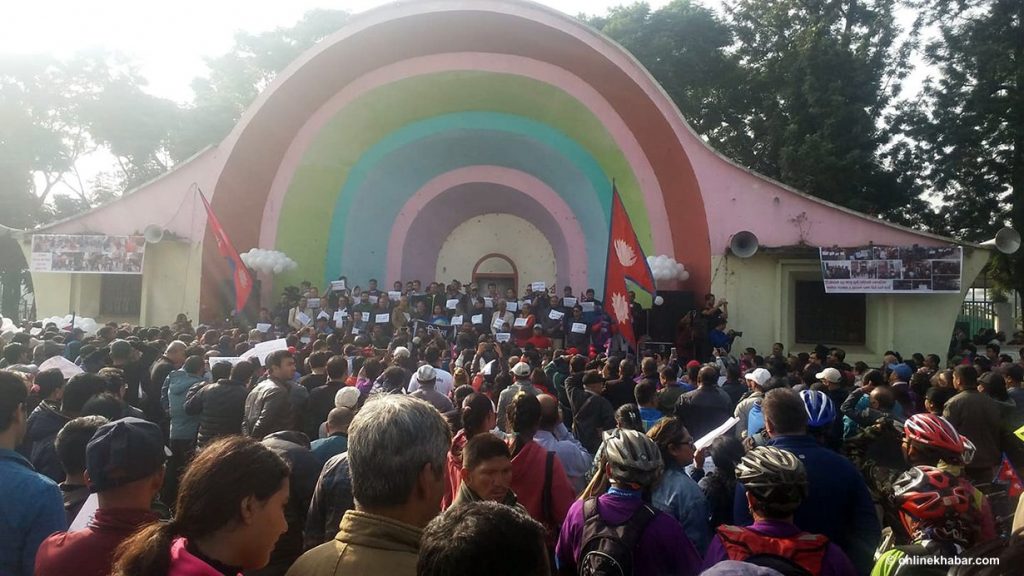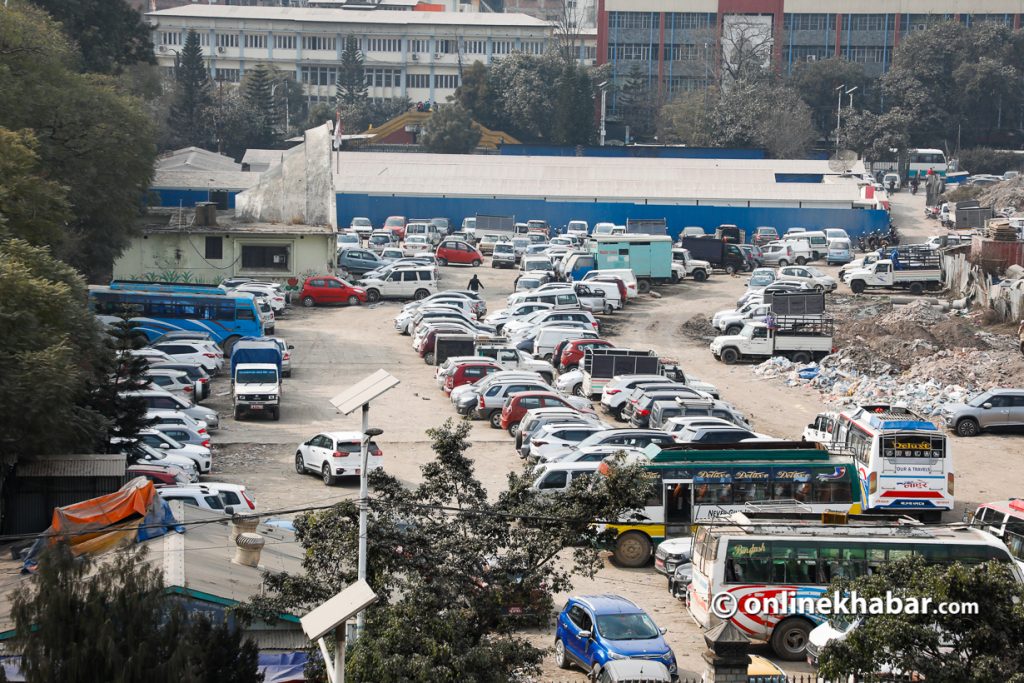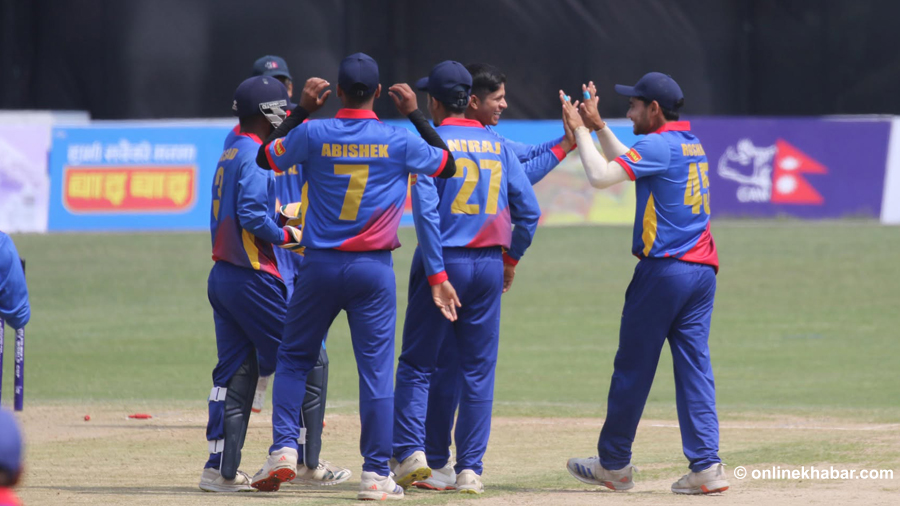
Kathmandu metropolitan city is studying to build a three-storey underground parking facility at Khulamanch to ‘solve’ the parking issue in the Kathmandu valley. But, a building to its southeast already has underground parking – the Kathmandu View Tower.
The tower project started nearly a decade ago with the same idea, solving the parking issue and having a managed bus terminal for public vehicles. But, despite the work on the underground parking has been completed, the city government has not been keen on operating it.
It instead has leased the building in a BOOT model to notorious and infamous contractor Manoj Bhetwal and his company Jaleshwor Swachchhanda Bkoi Builders Pvt Ltd for the next 30 years.
This has infuriated activists and open space campaigners who have condemned the city government for trying to encroach Khulamanch, one of the city’s last symbols of openness, in the name of an underground parking facility. This is particularly frustrating as activists started the Occupy Tudikhel campaign when the city government had allowed Bhetwal to set up a temporary bus terminal at Khulamanch just a few years ago.
Troubles with the tower

The city had panned for a bus terminal at Kathmandu View Tower. But, now, as the city government has been working with the Valley Traffic Police by forcing public busses to operate on a pickup and drop model, it says there is no need for a separate bus terminal for public transport.
So, what happens to the three-storey underground parking/bus terminal built underneath the Kathmandu View Tower? No one has a clear answer and that is where activists are angry as they believe that the metropolis has no plan as it left the already built underground parking useless and has set its sights on another open space in the valley that has both cultural and political significance.
The 11th floor of the Kathmandu View Tower is currently being constructed. The plan was to set up a bus terminal within a year of its construction. It has been nearly eight years since the construction, yet the metropolis has not shown any interest to operate the bus terminal.
Another underground parking lot has been built underneath the new Dharahara. But, the city has not even tried to use it before quickly announcing that it wants to solve the parking issue for the next 20 years by building a new parking lot underneath Khulamanch.
“All this has been decided without a public hearing or proper study,” says heritage activist Ganapati Lal Shrestha. “It’s sad that the city is leasing land under its name to private companies and eyeing public land for its gain.”
Greedy for public land

Khulamanch encroachment in the name of building an underground parking facility is wrong for different reasons, say activists like Shrestha.
Environmentalists and urban planners consider Tundikhel (and Khulamanch) as the lungs of Kathmandu due to its vastness. Along with its cultural and political importance, the place is a very important part of the city due to its openness, they say.
It is universally recognised that cities must have at least 12 per cent public open space to be livable. According to the national urban development strategy of the government, such an open area in Kathmandu is only 0.4 per cent. In most of these open spaces, the public is not allowed to enter.
The situation, when it comes to open public land, is dire. Yet, the government and different organisations continue to encroach on open land and build concrete structures on them.
Many also see the plan to build an underground parking lot at Khulamanch as an attempt to reject the political change by destroying a place that has meant so much politically over the course of half a century.
What makes it even weirder is the metropolis does not even own the land. It is public land.
According to the Land Revenue Office, Dillibazar, Khulamanch and Tundikhel are a part of the same lot and are owned by the government of Nepal.
But since the land has been used by the public, the public has a right to the land, says advocate Sanjay Adhikari.
The Local Government Operation Act, 2017, has given the local government a responsibility to protect public land like Khulamanch. But, in reality, the local government is trying to destroy it.
Illegal project

The ward office is the first protector of lands like these. But, the ward office of ward 28, where Khulamanch lies, does not have a clue about the metropolis’ plan to build a parking lot there.
“Not making the ward offices aware of such a project is illegal,” says Adhikari, “There hasn’t been a public hearing either, which is an important part before starting an ambitious project like this.”
“The metropolis is the protector of Khulamanch, not its owners,” says Adhikari. “The city needs to be responsible and work according to the country’s constitution and abide by its rules.”
According to him, it has been established by the court that public land should not be destroyed. When the government was about to give an open area in Balkhu to Gorkhapatra, in the case filed by Prakash Mani Sharma, the Supreme Court ordered the government not to give it to Gorkhapatra.
“The city should understand why that decision was made,” says Adhikari.
Hence, the activists are also preparing to knock on the door of the court to stop the city government from destroying Khulamanch in the name of an underground parking facility.
Finding a long-term solution

Many think that places like Khulamanch and Tundikhel were left behind while developing Kathmandu as a city. But, experts say the place has been an open space since the Malla era.
In Nepal Bhasa, Tudhikhel is called Tinikhya. Khya in Nepal Bhasa means an open space for people to play. Places like Tundikhel, Lagankhel, and Jawalakel, all were preserved for that purpose.
“This is not just a field. It has a lot of historical significance. They might be planning to do something good there, but they have to do that with transparency and public support,” says heritage expert Padma Sunder Joshi.
But, the metropolis has not even done a proper study if such an underground parking facility is needed to manage the traffic in the valley let alone hold a public discussion. Yet, it has already asked for a detailed project report from the Town Development Board.
Such a non-transparent manner in conducting work has started to pose questions if the metropolis wants to commercialise Khulamanch in the name of underground parking in the same manner it has commercialised the Old Bus Park by building a view tower.
Experts are concerned that this will give more incentive to increase commercialisation in the remaining open areas in the city.
They say public property should be used for the purpose for which it is offered or preserved. Those who are in charge of such property should work for the benefit of the community.
But, Kathmandu metropolitan city is doing whatever it wants, says activist Shrestha.
He says he fears building new underground parking facilities will make Kathmandu even more chaotic.
“They widened the road destroying the public’s houses. Did that solve the traffic issue? No, it made it worse. We need alternative plans that are sustainable,” says Shrestha.
This story was translated from the original Nepali version and edited for clarity and length.


























